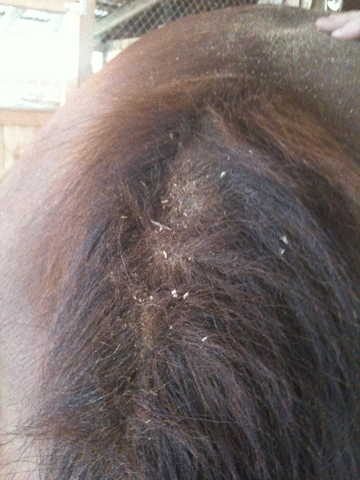
Horses can develop skin conditions for several reasons, ranging from weather related problems, increased insect activity, or a secondary infection. One equine dermatology expert describes some of the most common equine skin infections and how to identify, treat, and prevent them in your horses.
Rain Rot in Horses
Rain rot, true to its name, is typically caused by exposure to excessive moisture like rain and humidity, as well as bug bites. This is one of the most frequently seen skin conditions year-round, although horses are more prone to it in warmer months because of the increase in moisture exposure.
“Dermatophilosis Congolensis, the proper term for rain rot, is transmitted many times by fly bites,” says Rosanna Marsella, DVM, Dipl. ACVD, professor at the University of Florida, in Gainesville. “Horses that stand in the rain have skin that becomes soft and macerated. Then, if they get fly bites, they become even more prone to develop rain rot especially if they’re very young.”
If your horse develops rain rot, Marsella recommends trying a topical treatment like chlorhexidine or antimicrobial shampoo. Keep the horse’s skin clean, dry, and as bug-free as possible to help prevent and treat rain rot.
Ringworm (Dermatophytosis) in Horses
Ringworm is a type of fungal skin infection caused by dermatophytes such as Trichophyton and Microsporum species. Unlike many of the other common skin conditions, it can be easily transmitted to other horses, animals, and even people. Horses who develop ringworm will often have scaly bald patches, typically in a circular pattern, in the girth or saddle areas. However, the infection can spread to other areas like the head, neck, or chest.
“Ringworm is a contagious condition of the skin that’s typically seen more in young horses or older horses which are immunocompromised,” says Marsella. “The infection can develop once they’re exposed to the outer spores, which is the effective stage of the organism. This organism is typically passed from one horse to the other through grooming brushes or riding equipment. To establish an infection, you need to have some issue already with the skin or with the immune system because individuals may be exposed to it and not develop the clinical disease. Minimize any trauma to the skin, and I always advise against clipping unless it’s absolutely necessary.”
To help ensure your horse doesn’t get ringworm, make sure each horse in the barn has his own saddle pads, brushes, and other grooming and riding equipment. If your horse does develop ringworm, it can usually rectify on its own, but medicated shampoos or prescription products from your veterinarian might help clear it up faster.
Lice in Horses
Lice are easy to diagnose because the eggs attach to the hair, and the adults are typically large enough to easily see.
“Lice are host specific, which means people cannot get lice from their horses and vice versa,” says Marsella. “Lice are easily killed by pretty much any fly spray. If people routinely do fly control, you won’t get lice as well.” Horses are more likely to get lice in crowded environments or if they are malnourished, she added, noting that barn owners should always check new horses for lice.
Aural Plaques in Horses
Typically found inside of a horse’s ear, aural plaques, or papillary acanthoma, are another common occurrence. These nodules are hard to the touch and look white and flakey. If you notice your horse shaking its head more than usual or suddenly sensitive to being touched on the ear, he might have aural plaques.
“Insect control plays a role in preventing this condition since flies can transmit it,” says Marsella. “Put bug prevention on the poll and use products that have a neem oil or permethrin as the main ingredient to prevent flies from landing on the ears.” If lesions do develop in the ears, it’s always a good idea to have your vet take a biopsy to figure out the best course of action, she adds.
Secondary Skin Infections in Horses
Many common skin conditions can cause horses’ skin to become agitated and itchy. Because the horse scratches, rubs, or bites himself, trauma and inflammation of the skin occurs. This creates a perfect breeding ground for common secondary staph infections.
“We see Staphylococcus, also known as staph infections, which take over the skin,” says Marsella. “Anytime there is any form of trauma or inflammation to the skin, that’s when you get staphylococcus. For example, scratches are when the infection is localized to the legs, but we can also see a widespread infection.”
If a horse does get a secondary infection, Marsella encourages topical therapy first since staph is becoming antibiotic resistant. “For staph infections, chlorhexidine and antimicrobial shampoos are best. It doesn’t have to be the whole body, just the areas where they have scabs and infection. Massage it in, leave it there 5-10 minutes, and then rinse it off.”
Equine Eosinophilic Collagenolytic Granuloma can also be caused by inflammation of the skin and appears as round, firm, raised nodules, but the hair around them appears normal. “These are a calcium deposition and due to a horse having an insect allergy,” says Marsella. “For the insect allergy horses to help prevent these, it’s important to keep bug repellent on them all the time in warmer months.”
Take-Home Message
Rain rot, ringworm, lice, aural plaques, and secondary skin infections are common conditions seen on horses’ skin. Understanding how to identify them can help you and your veterinarian intervene quickly with appropriate treatment to reduce your horse’s risk of complications.


